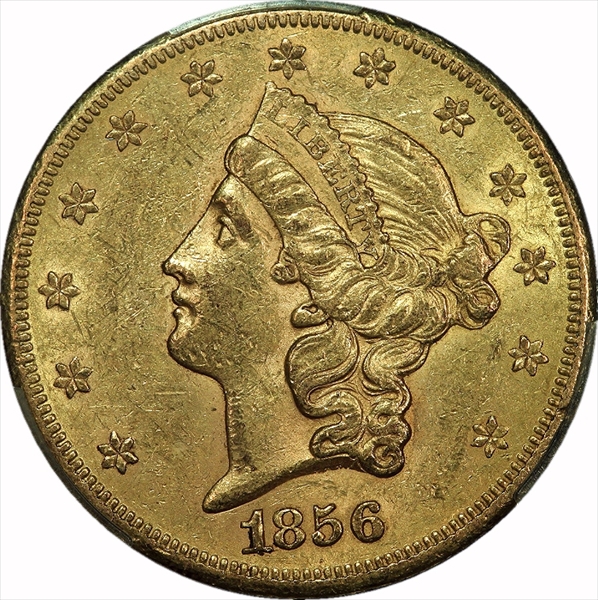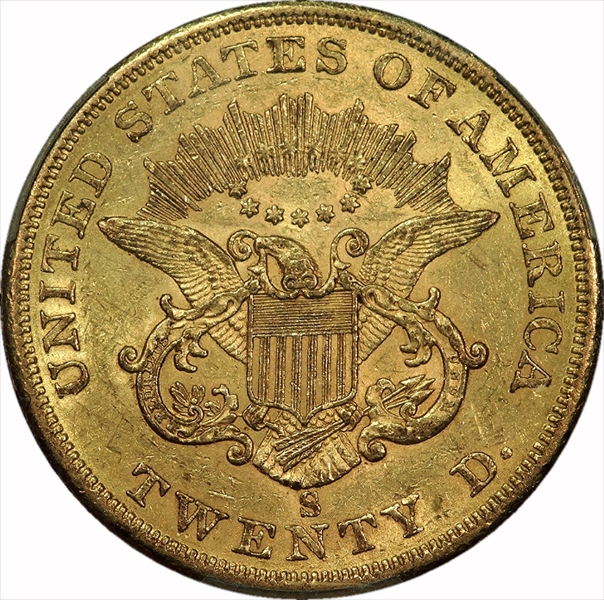1856-S $20 AU58 认证号39088478, PCGS号8919
拥有者评论
专家评论
Doug Winter
The following information is from my eBook on Type One Liberty Head Double Eagles at http://doubleeaglebook.com/Due to the discovery of a significant number of 1856-S double eagles in the S.S. Central America treasure (see below for more information), the 1856-S is now one of the three most available Type One double eagles.
STRIKE: The strike is similar to that seen on other San Francisco double eagles of this era. The obverse is sharp overall but may show weakness on the curls around the face, and especially on the curl below her ear. The hair at the top of the head is often weak as well. The obverse stars are sharp and often have full radial lines while the denticles are clearly separated. The reverse can show weakness at the center but it is well-defined overall. On some, there is minor weakness on the denticles.
SURFACES: The surfaces generally have numerous abrasions. However, it is easier to locate an example with clean fields than on most other issues of this type. Some have granular surfaces due to exposure to seawater. These are valued at lower levels than the coins from the S. S. Central America which have a very attractive appearance.
LUSTER: This was a well-produced issue and higher grade pieces have excellent luster. This is usually frosty in texture although some semi-prooflike pieces are known.
COLORATION: The natural coloration on 1856-S double eagles is a rich rose-gold with olive hues. Thanks to the addition of 1,000 examples into the market from the S.S. Central America, it is possible for the collector to easily obtain a high-grade example with great color.
EYE APPEAL: Even before the SSCA shipwreck coins were uncovered, the level of eye appeal for this date was above average. The 1856-S is well-struck and many coins have good luster and nice color. With little effort, the collector should find a handsome example for his set.
INTERESTING VARIETIES: All 1856-S double eagles have an Upright 5 in the date and a Medium S mintmark. Some show repunching on the 56. A total of 18 minor varieties have been identified in the S.S. Central America treasure.
PROOFS: No proofs were struck.
HOARDS: A total of 59 were found in the S.S. Republic. Three were in the S.S. Brother Jonathan, including one in Uncirculated. There were 1,085 in the S.S. Central America treasure including hundreds in Uncirculated. A group of “Choice Uncirculated” pieces are said to have come from a Northern California estate around 1973. A number were found in a shipwreck off the coast of Florida in the early 1970’s. More information on these can be found on page 84 of Dave Bowers’ book A Guide Book of Double Eagle Gold Coins.
BUYING TIPS: It is easy to determine non-shipwreck examples of this date and some collectors will gravitate towards these. Others will wish to purchase a nice S.S. Central America coin. Whichever version you decide to purchase, be patient as you are likely to be able to locate this date exactly as you want it.
AUCTION RECORD: The current auction record for this date is held by Heritage 1/12: 5033, graded MS66 by PCGS, and approved by CAC, which realized $74,750.
FINEST KNOWN: The finest known is a PCGS MS66 from the S.S. Central America which was last sold as Christie’s 12/00: 92 where it brought $57,500. The other PCGS MS66, last sold as Heritage 1/12: 5033 at $74,750 is not as appealing, in my opinion.
RARITY:
TOTAL KNOWN: 3000-4000+
BY GRADE:
Very Fine: 400-500
Extremely Fine: 900-1000
About Uncirculated: 1300-1500
Uncirculated: 400-500+
POPULATION FIGURES: The finest graded by PCGS as of the beginning of 2015 include 40 in MS64, one in MS64+, seven in MS65, and two in MS66. A total of 331 in the various Uncirculated grades have been slabbed by PCGS. The finest seen at NGC include four in MS63, two in MS64, and two in MS65. A total of 48 have been graded Uncirculated by this service, including eight from the S.S. Republic. CAC has approved two in MS61, one in MS62, three in MS63, two in MS64, and one in MS65, along with 29 other Uncirculated varieties earning a sticker.
PERFORMANCE SINCE 2002: In the current market, a choice About Uncirculated (equivalent to AU55) would sell in the $3,250-4,250 range. In 2002, the same quality coin would have sold for $1,500-2,000. In 2014, a nice Uncirculated 1856-S (equivalent to MS62) would sell in the $11,000-13,000 range. In 2002, the same coin (pedigreed to the S.S. Central America and in the original gold foil PCGS holder) would have brought $5,000-6,000. I think it is worth noting that nice Uncirculated examples of this date have outperformed their counterparts dated 1857-S.
COMMENTS: This date has had its level of rarity more profoundly affected than any other Type One with the exception of the 1857-S. That said, nice examples have shown good price appreciation over the last decade, and should continue to show strong demand.
Ron Guth
As noted above, the discovery of the wrecked ship SS Central America yielded a treasure trove of US gold coins. All told, the ship yielded more than 7,000 gold coins, including over 5,000 1857-S double eagles and over 1,500 1856-S double aagles. This unprecedented hoard allowed PCGS experts to examine each of the coins to determine different die varieties. Among the 1856-S double eagles,18 different varieties were identified, each of which was assigned a separate PCGS number for identification purposes. The varities ranged from different positions of the mintmark to missing serifs, broken A's, and/or combinations of the above. Most collectors purchase 1856-S double eagles sourced to the SS Central America for their overall quality. Where any Type 1 Double Eagle was a great rarity in the past, the collector now has access to thousands of Mint State examples, some quite choice. However, it should be noted that this hoard was distributed widely by telemarketers, and these coins come back into the market slowly at best.
The finest 1856-S double eagles certified by PCGS include two at the MS-66 level, and none finer.
David Akers (1975/88)
(PCGS CoinFacts editor's note: David Akers great book on Double Eagles was written in 1982, some 20 years before the SS Central America treasure hoard came to market. The hoard contained significant quantities of 1854-S, 1855-S, 1856-S and 1857-S $20 gold pieces. So here's what the rarity comments looked like prior to the SS Central America hoard.)
Although scarce, particularly in mint state, the 1856-S is one of the commonest Type I Double Eagles from the San Francisco Mint. It appeared at auction in the 443 catalogues surveyed more times than any other except the 1865-S, and it is offered in Unc. more times than any of the rest. These auction data coincide with my own personal experience and I would rate the 1856-S as the most likely Type I S-Mint Double Eagle to be available in full mint state. Many of the uncs are the "saltwater" variety with subdued lustre and slightly granular surfaces but I have also seen a small number of very nice original uncs including several that were gem quality. (One should not get the impression from these comments, however, that an Unc. 1856-S is not rare because it most certainly is. It is just not quite as rare as the other early S-Mint issues.) I have never seen a prooflike 1856-S; all of them were frosty.
稀有性和存量估计 了解更多
| 所有评级 | 3775 |
| 60或以上 | 462 |
| 65或以上 | 12 |
| 所有评级 | R-4.2 |
| 60或以上 | R-6.0 |
| 65或以上 | R-9.5 |
| 所有评级 | 37 / 44 TIE |
| 60或以上 | 39 / 44 |
| 65或以上 | 7 / 44 |
| 所有评级 | 80 / 148 TIE |
| 60或以上 | 84 / 148 TIE |
| 65或以上 | 31 / 148 TIE |
























